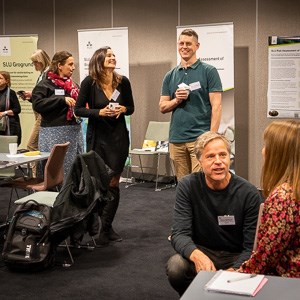Contact
Katja.Fedrowitz@slu.se, 018-67 21 96

We talk about plant health in forestry, agriculture, and horticulture, but the different areas are often compartmentalised. To increase cooperation in the field of plant health and plant protection, researchers from all of SLU's locations were invited to a networking meeting in Southern Sweden in October.
On October 9–10, the SLU Plant Protection Network and the SLU Forest Damage Centre arranged a networking symposium for researchers at SLU who are active in these areas. The meeting was started in Alnarp and ended in Malmö. During the first day, the participants were welcomed in the auditorium on Campus Alnarp. The day offered a poster session, presentations on plant health research at SLU, speed talks and excursions.
The Director of the SLU Forest Damage Centre, Jonas Rönnberg, and the Deputy Chair of the SLU Plant Protection Network, Laura Grenville-Briggs Didymus, presented an overview on research within forest damage and plant protection at SLU. Magnus Karlsson presented the Joint Action on Plant Health, an initiative by SLU and the Swedish Board of Agriculture for joint plant protection work. The goal is to highlight the crucial importance plant health has, so decision makers can include it in their actions.
– It was great that so many researchers travelled to Alnarp! These have been intense days with many new meetings and discussions, says Katja Fedrowitz, coordinator of the SLU Plant Protection Network and main organizer of the meeting.
– It is important to meet and discuss and investigate research ideas together. This meeting, with its friendly atmosphere, has been really good for that, says Malin Elfstrand from the Department of forest mycology and plant pathology in Uppsala.
The participants could choose between different excursions, including the Biotron, Alnarp Park, the Nordic Genetic Resource Center (NordGen), Alnarps landscape laboratory and the student initiative Alnarp’s Agroecology Farm.
– It was a good idea to combine research in agriculture and horticulture with research on forests. EU has many new calls, and this meeting was a good place to talk about new ideas for them, says Ramesh Vetukuri from the Department of plant breeding in Alnarp.
After the excursions, there was mingling at the posters and a joint dinner before the participants were shuttled to Malmö for an overnight stay.
– It was fun to see how PhD students in different fields socialized and had interesting discussions. That's what meetings like this are for, to build networks for your future career, says Åke Olson, who is responsible for the Forest Damage Centre’s research school.
The second day began with reflections on the previous day and then continued with lectures on plant protection in agriculture, horticulture and forestry. Malin Elfstrand moderated the session. Fredrik Widemo spoke about the effects of wild animals and damage in horticulture, on agricultural land and in forests. Then, Maria Sousa and Paul Becher talked about how chemical ecology can be used to fight pests. Aakash Chawade and Ke Zhang discussed examples of disease detection in agriculture and forestry. Finally, Johanna Boberg described what she does as an analyst working at the unit SLU Risk assessment of plant pests.
– This was a very useful meeting. I have met several new people who I can contact later about collaborations, said Chandra Krishnamurthy from the Department of forest economics in Umeå.
The day ended with a longer discussion session where the participants grouped themselves according to what they wanted to discuss. This was an opportunity to think about cross-faculty collaborations and to investigate new research ideas.
– We can really be isolated in our research silos, we think that forestry and agriculture are completely different things, but it does not have to be. These kind of meetings are good for breaking down these barriers between the silos. When you have met someone in real life, it is much easier to send them an e-mail, says Laura Grenville-Briggs Didymus, who helped to organize the meeting.
– It has been an interesting meeting with many discussions and new thoughts. We just received news that the SLU Plant Protection Network has additional funding for the whole of 2024 which is great, says Anneli Lundkvist, Chair of the SLU Plant Protection Network.
Katja.Fedrowitz@slu.se, 018-67 21 96